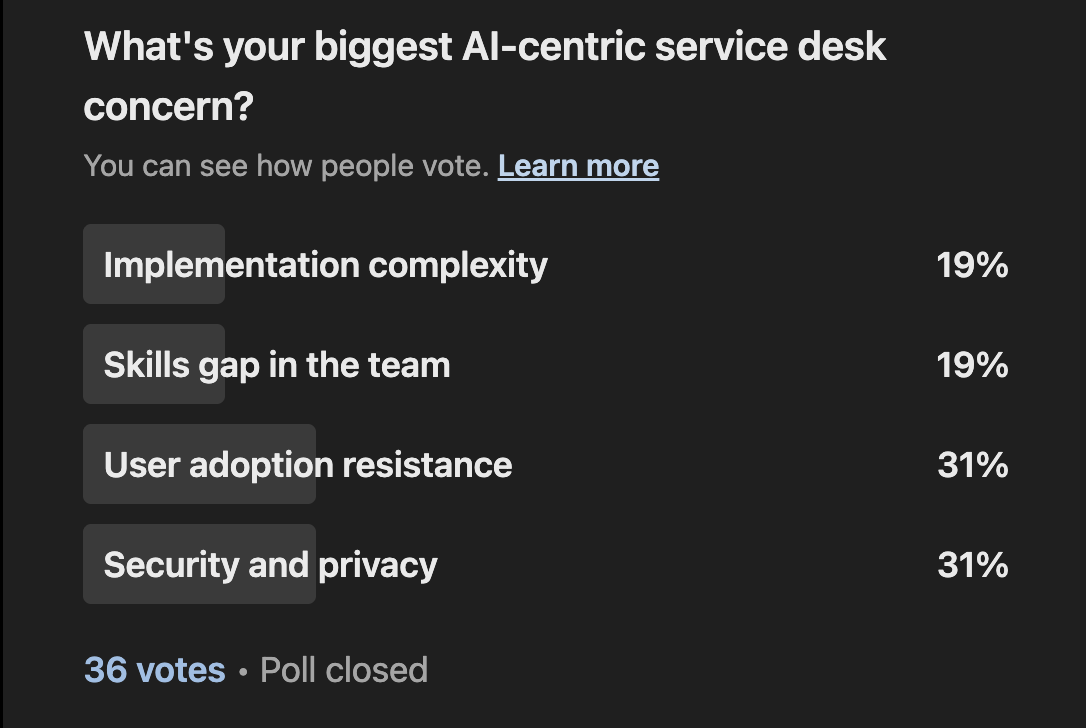Early Adopters Share AI-Centric Service Desk Results
The promise of AI-centric service desks has moved from theoretical blueprint to operational reality. After extensive research with early adopters across multiple industries, the results reveal a complex landscape where gains are marred with implementation challenges that many organizations didn’t anticipate. While the AI revolution may promise immediate and dramatic results, early adopters paint a more cautious picture of slower progress with measurable and achievable productivity gains, but a need to further demonstrate value to executives.
Early Outcomes Emerge From AI Adoption
The most successful AI-centric service desk implementations demonstrate clear productivity improvements, though not always where organizations expected them. One global technology company reported:
… over 50% gains in productivity for chat summarization, as an example … 75–80% of the volume primarily based on chats … about 30,000 chats every month.
Their virtual agent now resolves 65% of initial customer contacts without human intervention, fundamentally changing their staffing requirements. Consistency is achieved while also dramatically improving the productivity of agents.
A financial services organization took a calculated risk by reducing its frontline team from 30 to 12 agents while maintaining service levels through AI-powered automation. Users never noticed the reduction in human staff. Still, this success required substantial upfront investment in knowledge base development and months of fine-tuning before the AI could handle the volume effectively:
The staff went down to 12 from 30. We took a big risk in the beginning, but we felt it was a calculated risk, and we could augment that drop with the bot.
Perhaps most impressively, one retail organization automated one-third of its 57,000 annual service requests, eliminating human intervention for 20,000 routine tasks while maintaining proper approval workflows:
We averaged 57,000 requests last year for service … one-third of all those requests that came through were automated.
These organizations prove that AI service desk implementations can deliver on their promises, but success requires strategic planning and realistic timelines.
Knowledge Quality Determines AI Success
The foundation of every successful AI implementation proved to be robust, user-friendly knowledge bases. Organizations discovered that AI effectiveness directly correlates with the quality and volume of available knowledge articles, a requirement that caught many off guard since existing knowledge bases were often written for internal IT staff, not end users.
One IT leader who successfully implemented AI chat capabilities highlighted knowledge as a key to their success:
We had our internal knowledge base for IT, but it was never really exposed to users. This was the first time we actually had to make it user-friendly.
Their organization set monthly targets for knowledge article creation, focusing specifically on the highest-volume ticket categories to maximize AI effectiveness.
The barrier isn’t technological; it is content creation. Organizations find themselves in a race to generate sufficient knowledge base articles before their AI implementations can show a meaningful impact. Those who invested heavily in this foundation work saw early, faster returns; those who treated it as an afterthought struggled with AI effectiveness for months.
New Skill Development Is A Necessity
Contrary to predictions of dramatic staff reductions, successful AI implementations led to workforce reallocation rather than elimination. Organizations found their staff handling more complex issues while AI managed routine inquiries, elevating the role of service desk professionals and requiring higher technical proficiency across all levels. One infrastructure leader noted:
Our support staff had to learn automation skills — not how to use something automated but how to build automation into their everyday work.
Skill development is an unexpected but necessary investment, requiring organizations to either train existing staff or hire new talent with development capabilities.
The most successful organizations treated AI implementation as a career development opportunity. Staff who previously handled routine password resets now focus on root-cause analysis, process improvement, and advanced troubleshooting. This evolution requires significant investment in training and development, but organizations report higher job satisfaction and retention rates.
The results from a recent LinkeIn poll show that there is equal concern over end user adoption of AI in the service desk as well as security and privacy. We have a ways to go yet on the trust front.

Looking Forward
Early adopters offer clear guidance for organizations planning AI service desk implementations: invest heavily in knowledge base development before deploying AI capabilities, prepare for significant staff development requirements, and expect evolutionary rather than revolutionary change. The most successful implementations showed steady improvement over 6–12 months rather than immediate transformation.
The AI-centric service desk blueprint is sound, but successful execution requires patience, investment, and realistic expectations. Early adopters have proven the concept while providing the roadmap for sustainable implementation at scale. As these technologies mature and more organizations share their experiences, we can expect implementation best practices to evolve and success rates to improve.
What challenges has your organization faced in AI service desk implementation, and what unexpected benefits have you discovered along the way?
Read the report: The Forrester Guide To The AI-Centric Service Desk.
Let’s Connect
Have questions? That’s fantastic — let’s connect and continue the conversation! Please reach out to me through social media or request a guidance session. Follow my blogs and research at Forrester.com.
